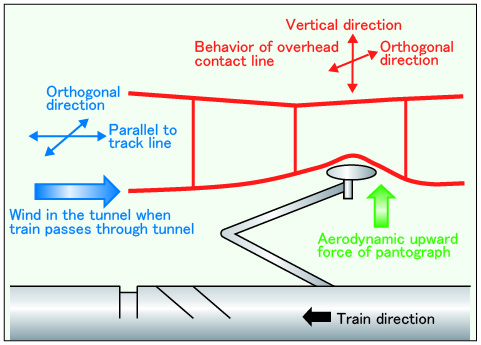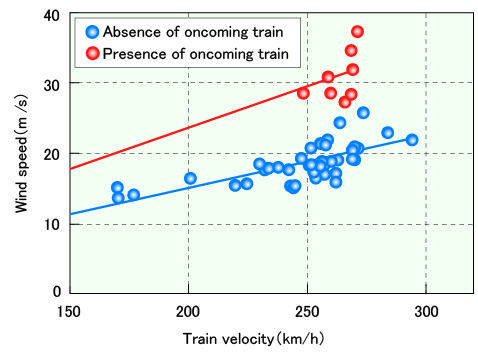8. Proposal for wind speed in tunnel to be used in the design and evaluation of overhead contact line facilities
- The wind speed which should be taken into account for the design of overhead contact lines and for forecasting current collection performance was clarified by using measured contact line behavior, wind speed and wind direction when trains pass through tunnels.
- Estimation of the pantograph upward force using the proposed wind speed, allows accurate forecast of current collection performance.
When a train runs through a tunnel, the air flow near the contact line influences the upward force of the pantograph, affecting the behavior of the contact line. This effect increases with running speed (Fig. 1). In order to clarify and improve contact line facility tolerances as running speeds increase, it is necessary to take into account and obtain more accurate measurements of wind speeds in tunnels.
Various measurements were therefore made as trains passed inside Shinkansen line tunnels, such as wind direction and wind speed around the overhead contact lines, displacement of the line and metal fittings and response forces. At the same time, using the results of wind speed measurements, estimates were made for the pantograph upward force as the train ran through the tunnel, which in turn were used to simulate the overhead contact line and pantograph at high speed to evaluate current collection performance.
Wind speed parallel to the track line was particularly high, and increased further in the case of an oncoming training also in the tunnel. (Fig2). Measurements were taken for different types of train running at different speeds. The maximum wind speeds to be considered with designing overhead lines for tunnels and forecasting current collection performance were arranged in order of train speed ratio (Table 1). Verifications were made with actual measurements and simulation to check the method when wire fitting displacement and response forces can rise quickly, under conditions such as when the pantograph upward force increases with the presence of an oncoming train. The proposed wind speed to be used in this method should allow more accurate estimation of current collection performance in relation to speed increases, by using wind speed.

Fig.1 Wind flow and contact wire behavior in the tunnel
Fig.2 Wind speed parallel to track line- Table 1 Wind speed to be considered for overhead contact line facilities
